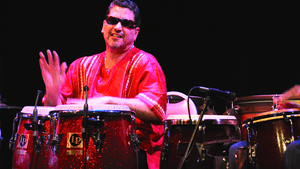Stay in the Loop
BSR publishes on a weekly schedule, with an email newsletter every Wednesday and Thursday morning. There’s no paywall, and subscribing is always free.
The African diaspora's Latin-Caribbean accent
Pablo Batista's 'El Viaje (The Journey)' at Temple University's Performing Arts Center

Pablo Batista’s El Viaje (The Journey), at Temple University’s Performing Arts Center, was like a happening. Attended by an enthusiastic audience of mostly African American and Latino cognoscenti, it was a memorable event. Some of the women’s attire rivaled the glamorous costumes presently in display at the Philadelphia Museum of Art exhibition, Creative Africa. I, for one, was happy to proudly be wearing my Caribbean tagua nut beads.
A figurative and literal tour de force
El Viaje is a multimedia tour de force with 19 musicians, seven dancers (choreographed by Cuban Philly transplant Gilset Mora), three vocalists, a narrator, and projections on a huge video screen that represent the difficult journey of the African people from their ancestral lands to America. Percussionist Batista — working with co-writers/arrangers Dennis Guevara and Victor Pablo Garcia-Gaetana — is a Temple alumnus (1986), Philadelphia resident, and nationally renowned composer. They structured the suite in eight movements taken from the roots of African folklore.
The cavernous theater’s large stage was filled with Batista’s impressive battery of congas, bongos, electronics high in the center, the Journey String Quartet, trumpets, trombones and other classical instruments at his left, and the piano, more percussion instruments, and vocalists on his right. The front of the stage was reserved for dancers who entered and exited from backstage on both sides, wearing many different ethnic costumes.
The journey begins
From the first, narrator Diane Leslie’s strong words made her one of the ensemble’s most dramatic performers: “I started in the Congo…I am Nefertiti’s mother.” With beautiful landscape images of Africa’s vastness onscreen, the audience was submerged in Yoruba rhythms accompanied by ancestral chants. One of my favorite movements was titled “The Passage.” Representing Africans’ perilous forced voyage from Africa to the Caribbean, it started with the amazing sounds of nature mimicked with musical instruments: Birds, wild animals, a rooster. The dancers, transformed into chained slaves being auctioned, danced as a narrator repeatedly called, “Bid them in. Bid them in.”
Having seen the provocative Underground Railroad Game at FringeArts this past spring, this depiction of historical events and enslaved Africans seemed innocent, almost trite and clichéd. A parade of three European friars, for example, was simply awkward. The dancers came into their own during “Arrival,” which highlighted American jazz and blues. Each dancer with his or her distinctive body shape and personality showed the beauty of diversity and individuality as well as the strength of the ensemble work.
Overcoming odds, opening doors
Pablo Batista grew up in Bethlehem, Pennsylvania, of Puerto Rican parents. He started playing drums when he was nine years old and graduated from Bethlehem Catholic High School before attending earning his B.F.A. at Temple. He teaches Afro-Caribbean percussion at The Association of Latin American Musicians (AMLA) and teaches master classes at Curtis Institute of Music. He has performed with Alicia Keys, Patti LaBelle, Teddy Pendergrass and others, and has received many awards, including some from the Pew Foundation, and four from the Pennsylvania Council on the Arts, which enabled him to do folkloric research in Cuba.
All these accomplishments come to mind during his performance and give it a sense of authenticity. His journey has been rich and successful, but undoubtedly there have been challenges; for one thing, he is blind.
I’m sure I wasn’t the only immigrant in the audience who felt moved to the core when the narrator said, “Where are my people who speak my language?” Towards the end of the program, she continued, “The traveler has to knock on each alien door.” Pablo Batista’s message resonates with today’s multicultural society and brings richness and beauty to this country’s diversity.
Despite aggressive publicity, the evening of the performance I attended was not nearly full. Looking at the audience, mostly middle aged, it became obvious to me that this show should occur when universities are not on summer break. Young students, thirsty for authenticity and culture, need to experience spectacles like this one. They would be proud to see a version of themselves on the stage — tattoos and all — and hear how ancestral rhythms have evolved into jazz, blues, even funk and break dance or salsa, cha-cha, and Latin pop.
What, When, Where
El Viaje (The Journey). By Pablo Batista, Dennis Guevara, Victor Pablo Garcia-Gaetana. Through June 26, 2016 at Temple University Performing Arts Center, 1837 N. Broad Street, Philadelphia. (215) 204-9680 or templeperformingartscenter.org.
Sign up for our newsletter
All of the week's new articles, all in one place. Sign up for the free weekly BSR newsletters, and don't miss a conversation.

 Concha Alborg
Concha Alborg